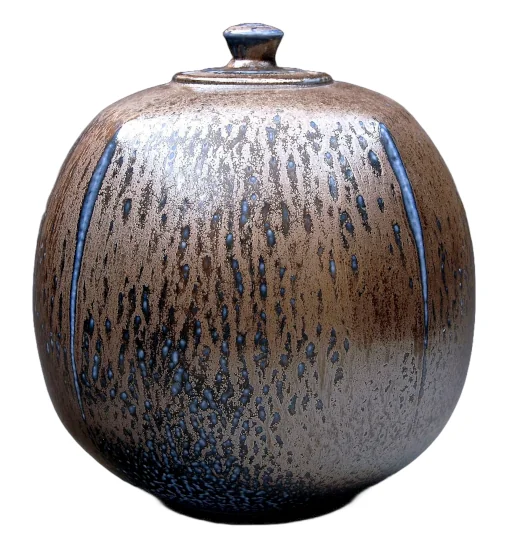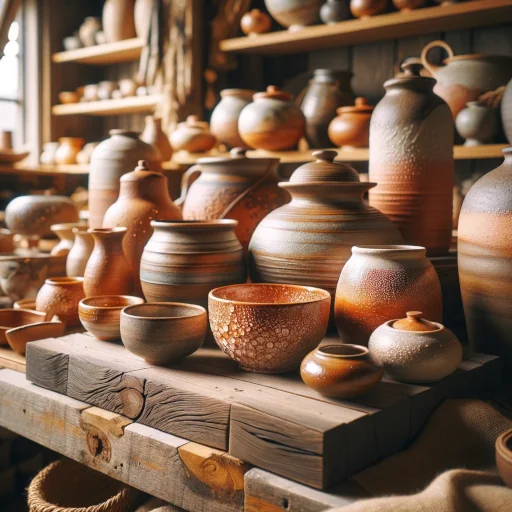Salt glazing is a pottery technique where salt is added to a kiln during firing, creating a distinctive, glassy surface. The salt reacts with silica in the clay, forming a glossy, orange-peel texture, often with color variations.
It’s, a fascinating chapter in the story of ceramic artistry, stands out for its distinctive charm. This method, where salt is introduced during the high-temperature phase of kiln firing, results in a uniquely textured glaze. Think of it as the pottery world’s way of seasoning its creations, much like a chef adds salt for flavor. The resulting glaze has a characteristic orange-peel texture, offering both beauty and practicality.
To truly appreciate this technique’s nuances, I recommend diving into the rich details provided in our earlier piece: “Exploring the Art of Salt Glazed Pottery”. Here, you’ll find a foundational understanding, setting the stage for a deeper exploration into the vast realm of ceramic glazing techniques.
Deeper Dive into Historical Context

Origins and Evolution
Salt glazing began in the 14th century in Germany’s Rhineland, marking a pivotal innovation in European pottery. This technique, involving throwing salt into a kiln at high temperatures, revolutionized pottery’s aesthetics and functionality.1
Regional Variations and Cultural Significance
- Rhineland, Germany: The birthplace of salt glazing, known for its robust stoneware.
- England and Colonial America: Adopted in the 17th century, prominently featured in domestic wares.
- Japan: Bernard Leach and Shōji Hamada introduced it in the 20th century, blending Eastern and Western pottery styles.2
Salt glazing’s journey from a medieval European innovation to a globally appreciated art form mirrors the evolution of ceramic arts. Each region infused its cultural essence, making salt glazing a tapestry of global artistic expression.
Technical Aspects
The Chemistry Behind Salt Glazing
Let’s delve a bit deeper into the chemistry of salt glazing. When salt (sodium chloride) is introduced into a hot kiln, it vaporizes. The sodium in the salt reacts with silica in the clay, creating a layer of sodium silicate. This reaction is what gives salt-glazed pottery its unique, glassy surface.
Temperature and Kiln Atmosphere
- Temperature: Typically, salt is introduced at around 2200°F. The higher the temperature, the more intense the reaction, leading to variations in texture and sheen.
- Kiln Atmosphere: Oxygen levels in the kiln affect the outcome. A reduction atmosphere, with less oxygen, can alter the glaze’s appearance, often deepening colors and influencing the glaze’s texture.
Understanding these technicalities is crucial. They’re not just scientific details; they’re the alchemy that turns ordinary clay into extraordinary art.
Contemporary Practices

Insights from Phil Rogers, Author of “Salt Glazing”
- Question: What was your main purpose for writing “Salt Glazing”? Phil: My purpose for writing “Salt Glazing” was to explore the diverse approaches to the salt-glazing process among potters, rather than providing a standard manual.
- Question: How is your book on salt glazing composed? Phil: The book is composed of individual stories and experiences from various potters, focusing more on narrative and personal journeys rather than technical instructions.
- Question: What fascinates you about salt glazing? Phil: Salt glazing is fascinating because it’s simple yet complex, requiring meticulous control and an intuitive understanding of firing. It allows for great creativity and endless experimentation, leading to rich textures and colors.
- Question: After talking with many potters, what do you find is the attraction to salt glazing? Phil: The attraction lies in the combination of working with the basic elements of pottery – clay, fire, and vapor – and the magical alchemy during the firing process. It’s like racing an open-top sports car; thrilling, elemental, and slightly unpredictable.
Environmental and Health Considerations in Salt Glazing
Impact of Traditional Salt Glazing
Salt glazing, while artistically enriching, raises certain environmental and health concerns. Traditionally, the process involves high-temperature firing and the use of salt, which can release harmful sodium and chlorine vapors. These emissions have implications for both the potter’s health and the environment.
Modern Adaptations for Sustainability
To mitigate these impacts, contemporary potters and studios are adopting more eco-friendly practices. These include:
- Using alternative materials: Substituting traditional salt with less harmful materials that produce similar glazing effects.
- Kiln modifications: Updating kiln designs to improve efficiency and reduce emissions.
- Ventilation improvements: Enhancing studio ventilation systems to protect potters from inhaling harmful fumes.
Through these adaptations, the pottery community is striving to preserve the art of salt glazing while ensuring its practice aligns with modern environmental and health standards. This balance between tradition and innovation not only safeguards our planet but also ensures that the art of salt glazing can be safely practiced and appreciated by future generations. By embracing these changes, the pottery world is contributing to a more sustainable and health-conscious artistic environment.
Artistic Expression Through Salt Glazing

The Aesthetic Choices in Salt Glazing
Salt glazing offers a unique canvas for artistic expression. The unpredictability of the salt’s reaction with the silica in the clay provides a distinctive, textured surface that varies with each firing. This unpredictability is a boon for artists, offering a range of aesthetic outcomes from rustic charm to elegant sheen, depending on the firing conditions and clay composition.
Comparisons with Other Glazing Techniques
- Control and Predictability: Unlike more predictable glazes like underglaze or overglaze, salt glazing is less controllable, making each piece uniquely unpredictable.
- Texture and Finish: Salt glazing often results in a rougher, more organic texture compared to the smoother finishes of other techniques.
- Color Variations: While other techniques allow for a broader range of colors, salt glazing typically produces earthy tones, imbuing each piece with a natural, grounded feel.
In essence, salt glazing is a dance between the potter, the elements, and the kiln. It’s a celebration of natural beauty, where the artist embraces the serendipity of the process to create works that resonate with raw, elemental charm.
Linking Past and Present
Influence of Historical Methods on Contemporary Practices
Historical methods of salt glazing have laid the foundation for contemporary practices. Modern potters draw inspiration from ancient techniques, often blending traditional methods with personal artistic styles. This respect for historical practices enriches the depth and diversity of contemporary salt-glazed works.
Role of Technology in Evolving Techniques
Advancements in kiln technology and materials science are revolutionizing salt glazing. Digital kiln controllers, improved ventilation systems, and eco-friendly glazing materials enable potters to experiment with new techniques while reducing environmental impact. Technology is thus bridging the gap between historical authenticity and modern efficiency, allowing for a sustainable continuation of this ancient art form.
FAQ
What is salt glazing made of?
Salt glazing is made by introducing salt (sodium chloride) into a kiln at high temperatures, where it reacts with silica in the clay to form a glassy sodium silicate glaze.
What is salt glaze pottery value?
The value of salt glaze pottery varies based on age, condition, rarity, and the artist. Antique pieces and works by renowned potters can be quite valuable.
What is salt glazing for pottery?
Salt glazing is a technique used to create a distinctive textured, glossy surface on pottery, characterized by an orange-peel texture.
How to identify salt-glazed pottery?
Salt-glazed pottery can be identified by its glassy, orange-peel texture, typically in earthy tones, and often with a slightly rough surface.
What are some simple salt glaze recipes?
Simple salt glaze recipes generally involve basic salt (sodium chloride) introduced into the kiln; exact recipes can vary based on desired textures and effects.
Can you salt glaze in an electric kiln?
Traditionally, salt glazing is done in gas or wood-fired kilns due to the corrosive nature of salt vapors, but there are adapted methods for electric kilns using salt slips.
How to date salt-glazed pottery?
Dating salt-glazed pottery involves examining characteristics like marks, glaze texture, and style, and understanding the historical context of salt glazing techniques.
Is salt glazed pottery safe?
Salt-glazed pottery is generally safe for decorative purposes. If used for food, ensure it’s lead-free and the glaze is well-fitted to avoid leaching.
Interactive FAQs
Footnotes





